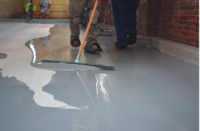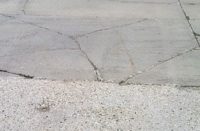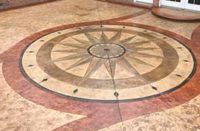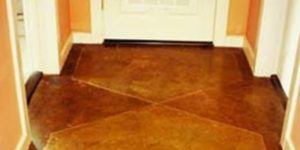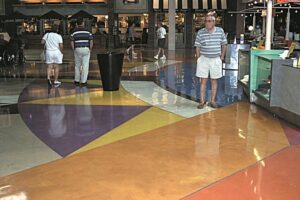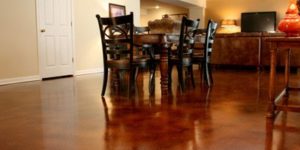
The defeated firemen rolled up their hoses and put away the axes. The look on the bystanders’ faces said it all. Everyone knew the hopes and dreams of this Eastern Sierra lodge lay somewhere under the smoldering timbers.
Not long after, someone had an idea to rebuild, but this time use products more fire-resistant. Famed architect Gilbert Stanley Underwood liked the idea of using concrete in every way possible. He suggested decorative concrete floors, walls, beams and flatwork.
Everyone agreed. But the decision makers wanted the assurance that the building would have the natural look so commonly seen in the High Sierras — and not the look of industrial concrete. Underwood assured everyone involved that the finished product, through the use of decorative concrete, would look as natural as stone and timber.

I recently had the opportunity to visit this lodge in preparation for a television feature on decorative concrete. What a treat. This magnificent multistory hotel was even more impressive in person than I could imagine. I truly believe it would match up to the billion-dollar resorts springing up in Vegas. The acid-stained floors seem to run for miles with art deco bands and accents throughout. I searched the floor thoroughly looking for flaws or cut corners, but found none. The scoring that makes up thousands of feet of design is not created by diamond blades but by hand tooling. The outside walls appear to be made of redwood timbers but are actually made of stained concrete poured between timbers. The rafter tails replicate the same detail but are made of rock, sand and cement. The outside flatwork is a natural gray but is imprinted to have a look of flagstone.
You may be asking yourself who had the honor of installing this work of decorative art. Was it Chris Becker and his decorative team from Minnesota? Maybe Fu-Tung Cheng with his legendary knowledge of decorative concrete. Surely the flatwork was trusted to decorative commodities like Colorado Hardscapes or Richard Smith Custom Concrete. Nope, not even close. Not even the heavy hitters in today’s decorative market had an opportunity at this project. How could they? They weren’t even born when this decorative masterpiece was completed in 1927. The most significant specimen of decorative concrete in existence, the Ahwahnee Hotel, was completed nearly 30 years before Brad Bowman started Bomanite. Do yourself a favor and someday visit this treasure that sits in the meadows of Yosemite National Park.
I’m sure that I looked like the biggest concrete geek on the planet as I poked around the Ahwahnee Hotel during my visit. One lady asked me what I was looking at as I explained the reason for my visit. She said that she loved the stained floors and was picturing something like that in her new home. Bingo. Decorative concrete was the right choice in 1927 and it is still the right choice now. I would say that is staying power — but will all types of decorative concrete have the same fate? It is quite possible that some types will be sandwiched somewhere between shag carpet and Formica counters in the home improvement graveyard. It’s hard to say for sure but my money is on decorative types that offer a timeless presence. Most forms of decorative concrete are market-driven, but some are influenced by manufacturers. Be careful of the latter.
Below are a few ways to insure your work is admired for years to come.
— Replicate natural materials when designing and installing projects. Things like slate, stone, and rock will fit into present architectural styles with only a few exceptions. Replicate natural materials such as stone and rock when designing and installing projects. Familiarize yourself with the natural design of fissures, strata, and veins that flow naturally in rock and stone formations. These imperfections make the perfect recipe for a natural concrete appearance.
— Favor earth-tone colors as dominant color choices and use less trendy colors to shade or highlight. It may be tempting to use some of the new and vibrant colors found in today’s market, but be aware that trendy colors and designs can be short-lived. I understand that your local Harley dealership will most likely look for something more cutting-edge and this is completely understandable.
— Incorporate real wood, stone or tile into your decorative designs. Nothing guarantees a timeless look better than blending natural resources into the decorative package. One usually compliments the other and there is room in today’s market for all of the above. Kudos to the countertop industry for incorporating inlays such as seashells and colorful aggregates — you guys keep raising the bar and I love it.
— Be careful of some stencil and knock-down-style finishes. I’m not painting all of these types with the same broad brush but some have a tendency of not looking natural. These products should always be used in natural earth-tone colors to help appear organic. All exterior work should be sealed with semigloss or flat. Don’t forget the nonskid for traction.
— Trends will come and go so try not to force the market to accept a certain style. Like everything, trends are about timing and can be challenging to predict. A prime example is the number of hardwood floors that were covered with carpet, only to be discovered years later.
The bottom line is, the decorative market is going to be around for a long time. Come to think of it, it already has been.
